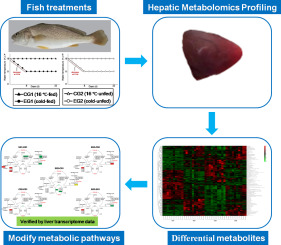当前位置:
X-MOL 学术
›
Sci. Total Environ.
›
论文详情
Our official English website, www.x-mol.net, welcomes your
feedback! (Note: you will need to create a separate account there.)
Physiological responses to cold and starvation stresses in the liver of yellow drum (Nibea albiflora) revealed by LC-MS metabolomics.
Science of the Total Environment ( IF 8.2 ) Pub Date : 2020-01-25 , DOI: 10.1016/j.scitotenv.2020.136940 Shuang Jiao 1 , Miaomiao Nie 2 , Hongbin Song 3 , Dongdong Xu 3 , Feng You 1
Science of the Total Environment ( IF 8.2 ) Pub Date : 2020-01-25 , DOI: 10.1016/j.scitotenv.2020.136940 Shuang Jiao 1 , Miaomiao Nie 2 , Hongbin Song 3 , Dongdong Xu 3 , Feng You 1
Affiliation

|
As global climate changes, mass mortality in farmed fish associated with the severely cold weather has aroused growing concerns. Yellow drum (Nibea albiflora) is an important maricultured fish in China, whereby its aquaculture suffered from overwinter mortality associated with cold and cold-induced-fasting stresses. Here, by using LC-MS metabolomics combined with transcriptomics, we investigated the physiological responses of yellow drum liver to cold and starvation stresses. The experiment involved four groups: 16 °C fed group (CG1), 16 °C unfed group (CG2), 8 °C fed group (EG1), and 8 °C unfed group (EG2). Under cold stress, a total of 308 and 257 differential metabolites were identified in EG1 vs. CG1 and EG2 vs. CG2, respectively, showing 5 overlapping significant pathways: glutathione metabolism, biosynthesis of unsaturated fatty acids, galactose metabolism, arginine and proline metabolism, and ABC transporters. Intersection analysis identified that glutamate, oxidized glutathione (GSSG), and eicosenoic acid were the common metabolites induced by cold stress. Under starvation stress, a total of 300 and 215 differential metabolites were identified in CG2 vs. CG1 and EG2 vs. EG1, respectively, showing 2 overlapping significant pathways: glutathione metabolism and galactose metabolism. Intersection analysis revealed that glutamate and GSSG were the common metabolites caused by fasting. Under cold and starvation combined stresses, 286 differential metabolites were identified in EG2 vs. CG1, showing 7 influenced pathways: glycerophospholipid metabolism, biosynthesis of unsaturated fatty acids, glutathione metabolism, sphingolipid metabolism, glycosylphosphatidylinositol (GPI)-anchor biosynthesis, autophagy, and purine metabolism. Interestingly, the glutamate and GSSG were induced by both single and combined stresses of cold and starvation treatments. These findings suggest that glutathione metabolism and its related metabolites (glutamate and GSSG) could be potential biomarkers of cold and starvation stresses in yellow drum. Overall, the results of this study provided insights into the physiological regulation in response to cold and starvation stresses in this fish.
更新日期:2020-01-26











































 京公网安备 11010802027423号
京公网安备 11010802027423号